In-depth Review: Victorian Public Health & Wellbeing Plan (2015-2019)
VerifiedAdded on 2023/06/14
|9
|2156
|127
Report
AI Summary
This report provides a detailed review of the Victorian Public Health and Wellbeing Plan (VPHWP) (2015-2019), which aims to promote health and wellbeing among the Victorian population. It outlines the plan's objectives, which are consistent with the Public Health and Wellbeing Act of 2008, and its focus on reducing health inequalities by addressing social determinants of health. The review identifies tobacco-free living as a key priority area, targeting high smoking rates among Aboriginal people and adolescents. It further analyzes the social, biological, and environmental determinants contributing to smoking prevalence among Aboriginal adults, including economic instability, poor health, and living in remote areas. The report concludes by emphasizing the importance of addressing these determinants to achieve health equity and improve overall wellbeing in Victoria.
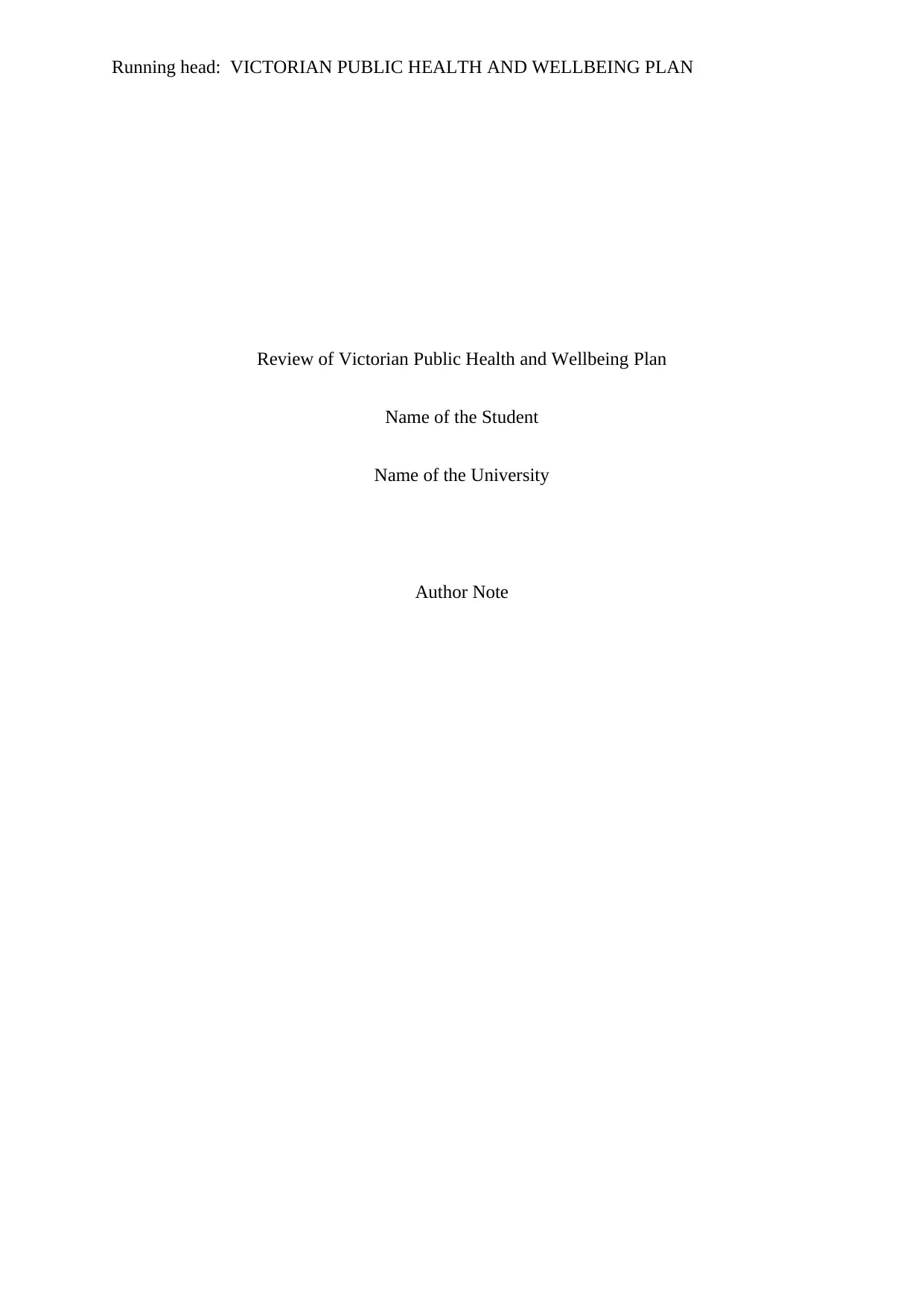
Running head: VICTORIAN PUBLIC HEALTH AND WELLBEING PLAN
Review of Victorian Public Health and Wellbeing Plan
Name of the Student
Name of the University
Author Note
Review of Victorian Public Health and Wellbeing Plan
Name of the Student
Name of the University
Author Note
Paraphrase This Document
Need a fresh take? Get an instant paraphrase of this document with our AI Paraphraser
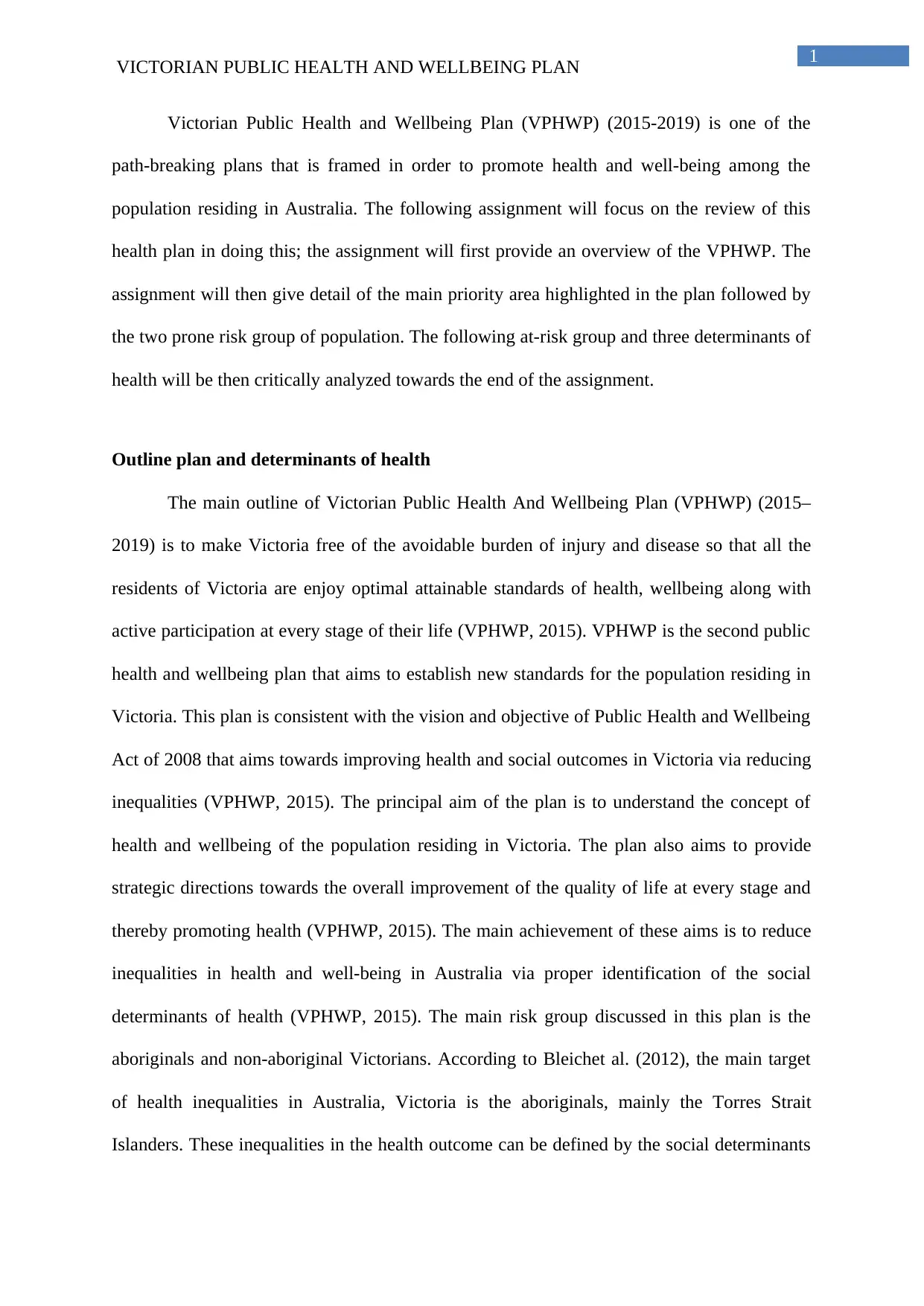
1
VICTORIAN PUBLIC HEALTH AND WELLBEING PLAN
Victorian Public Health and Wellbeing Plan (VPHWP) (2015-2019) is one of the
path-breaking plans that is framed in order to promote health and well-being among the
population residing in Australia. The following assignment will focus on the review of this
health plan in doing this; the assignment will first provide an overview of the VPHWP. The
assignment will then give detail of the main priority area highlighted in the plan followed by
the two prone risk group of population. The following at-risk group and three determinants of
health will be then critically analyzed towards the end of the assignment.
Outline plan and determinants of health
The main outline of Victorian Public Health And Wellbeing Plan (VPHWP) (2015–
2019) is to make Victoria free of the avoidable burden of injury and disease so that all the
residents of Victoria are enjoy optimal attainable standards of health, wellbeing along with
active participation at every stage of their life (VPHWP, 2015). VPHWP is the second public
health and wellbeing plan that aims to establish new standards for the population residing in
Victoria. This plan is consistent with the vision and objective of Public Health and Wellbeing
Act of 2008 that aims towards improving health and social outcomes in Victoria via reducing
inequalities (VPHWP, 2015). The principal aim of the plan is to understand the concept of
health and wellbeing of the population residing in Victoria. The plan also aims to provide
strategic directions towards the overall improvement of the quality of life at every stage and
thereby promoting health (VPHWP, 2015). The main achievement of these aims is to reduce
inequalities in health and well-being in Australia via proper identification of the social
determinants of health (VPHWP, 2015). The main risk group discussed in this plan is the
aboriginals and non-aboriginal Victorians. According to Bleichet al. (2012), the main target
of health inequalities in Australia, Victoria is the aboriginals, mainly the Torres Strait
Islanders. These inequalities in the health outcome can be defined by the social determinants
VICTORIAN PUBLIC HEALTH AND WELLBEING PLAN
Victorian Public Health and Wellbeing Plan (VPHWP) (2015-2019) is one of the
path-breaking plans that is framed in order to promote health and well-being among the
population residing in Australia. The following assignment will focus on the review of this
health plan in doing this; the assignment will first provide an overview of the VPHWP. The
assignment will then give detail of the main priority area highlighted in the plan followed by
the two prone risk group of population. The following at-risk group and three determinants of
health will be then critically analyzed towards the end of the assignment.
Outline plan and determinants of health
The main outline of Victorian Public Health And Wellbeing Plan (VPHWP) (2015–
2019) is to make Victoria free of the avoidable burden of injury and disease so that all the
residents of Victoria are enjoy optimal attainable standards of health, wellbeing along with
active participation at every stage of their life (VPHWP, 2015). VPHWP is the second public
health and wellbeing plan that aims to establish new standards for the population residing in
Victoria. This plan is consistent with the vision and objective of Public Health and Wellbeing
Act of 2008 that aims towards improving health and social outcomes in Victoria via reducing
inequalities (VPHWP, 2015). The principal aim of the plan is to understand the concept of
health and wellbeing of the population residing in Victoria. The plan also aims to provide
strategic directions towards the overall improvement of the quality of life at every stage and
thereby promoting health (VPHWP, 2015). The main achievement of these aims is to reduce
inequalities in health and well-being in Australia via proper identification of the social
determinants of health (VPHWP, 2015). The main risk group discussed in this plan is the
aboriginals and non-aboriginal Victorians. According to Bleichet al. (2012), the main target
of health inequalities in Australia, Victoria is the aboriginals, mainly the Torres Strait
Islanders. These inequalities in the health outcome can be defined by the social determinants
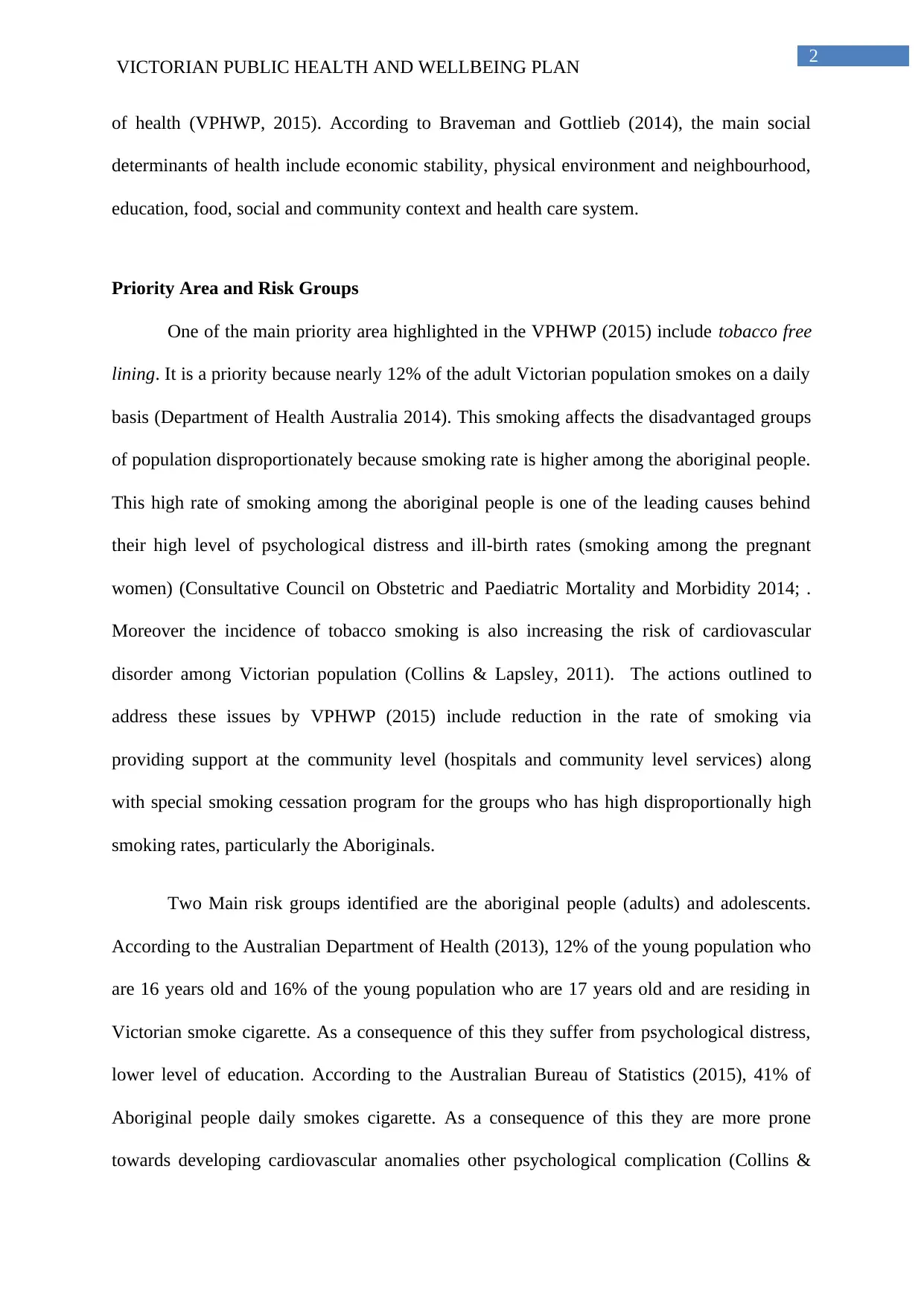
2
VICTORIAN PUBLIC HEALTH AND WELLBEING PLAN
of health (VPHWP, 2015). According to Braveman and Gottlieb (2014), the main social
determinants of health include economic stability, physical environment and neighbourhood,
education, food, social and community context and health care system.
Priority Area and Risk Groups
One of the main priority area highlighted in the VPHWP (2015) include tobacco free
lining. It is a priority because nearly 12% of the adult Victorian population smokes on a daily
basis (Department of Health Australia 2014). This smoking affects the disadvantaged groups
of population disproportionately because smoking rate is higher among the aboriginal people.
This high rate of smoking among the aboriginal people is one of the leading causes behind
their high level of psychological distress and ill-birth rates (smoking among the pregnant
women) (Consultative Council on Obstetric and Paediatric Mortality and Morbidity 2014; .
Moreover the incidence of tobacco smoking is also increasing the risk of cardiovascular
disorder among Victorian population (Collins & Lapsley, 2011). The actions outlined to
address these issues by VPHWP (2015) include reduction in the rate of smoking via
providing support at the community level (hospitals and community level services) along
with special smoking cessation program for the groups who has high disproportionally high
smoking rates, particularly the Aboriginals.
Two Main risk groups identified are the aboriginal people (adults) and adolescents.
According to the Australian Department of Health (2013), 12% of the young population who
are 16 years old and 16% of the young population who are 17 years old and are residing in
Victorian smoke cigarette. As a consequence of this they suffer from psychological distress,
lower level of education. According to the Australian Bureau of Statistics (2015), 41% of
Aboriginal people daily smokes cigarette. As a consequence of this they are more prone
towards developing cardiovascular anomalies other psychological complication (Collins &
VICTORIAN PUBLIC HEALTH AND WELLBEING PLAN
of health (VPHWP, 2015). According to Braveman and Gottlieb (2014), the main social
determinants of health include economic stability, physical environment and neighbourhood,
education, food, social and community context and health care system.
Priority Area and Risk Groups
One of the main priority area highlighted in the VPHWP (2015) include tobacco free
lining. It is a priority because nearly 12% of the adult Victorian population smokes on a daily
basis (Department of Health Australia 2014). This smoking affects the disadvantaged groups
of population disproportionately because smoking rate is higher among the aboriginal people.
This high rate of smoking among the aboriginal people is one of the leading causes behind
their high level of psychological distress and ill-birth rates (smoking among the pregnant
women) (Consultative Council on Obstetric and Paediatric Mortality and Morbidity 2014; .
Moreover the incidence of tobacco smoking is also increasing the risk of cardiovascular
disorder among Victorian population (Collins & Lapsley, 2011). The actions outlined to
address these issues by VPHWP (2015) include reduction in the rate of smoking via
providing support at the community level (hospitals and community level services) along
with special smoking cessation program for the groups who has high disproportionally high
smoking rates, particularly the Aboriginals.
Two Main risk groups identified are the aboriginal people (adults) and adolescents.
According to the Australian Department of Health (2013), 12% of the young population who
are 16 years old and 16% of the young population who are 17 years old and are residing in
Victorian smoke cigarette. As a consequence of this they suffer from psychological distress,
lower level of education. According to the Australian Bureau of Statistics (2015), 41% of
Aboriginal people daily smokes cigarette. As a consequence of this they are more prone
towards developing cardiovascular anomalies other psychological complication (Collins &
⊘ This is a preview!⊘
Do you want full access?
Subscribe today to unlock all pages.

Trusted by 1+ million students worldwide
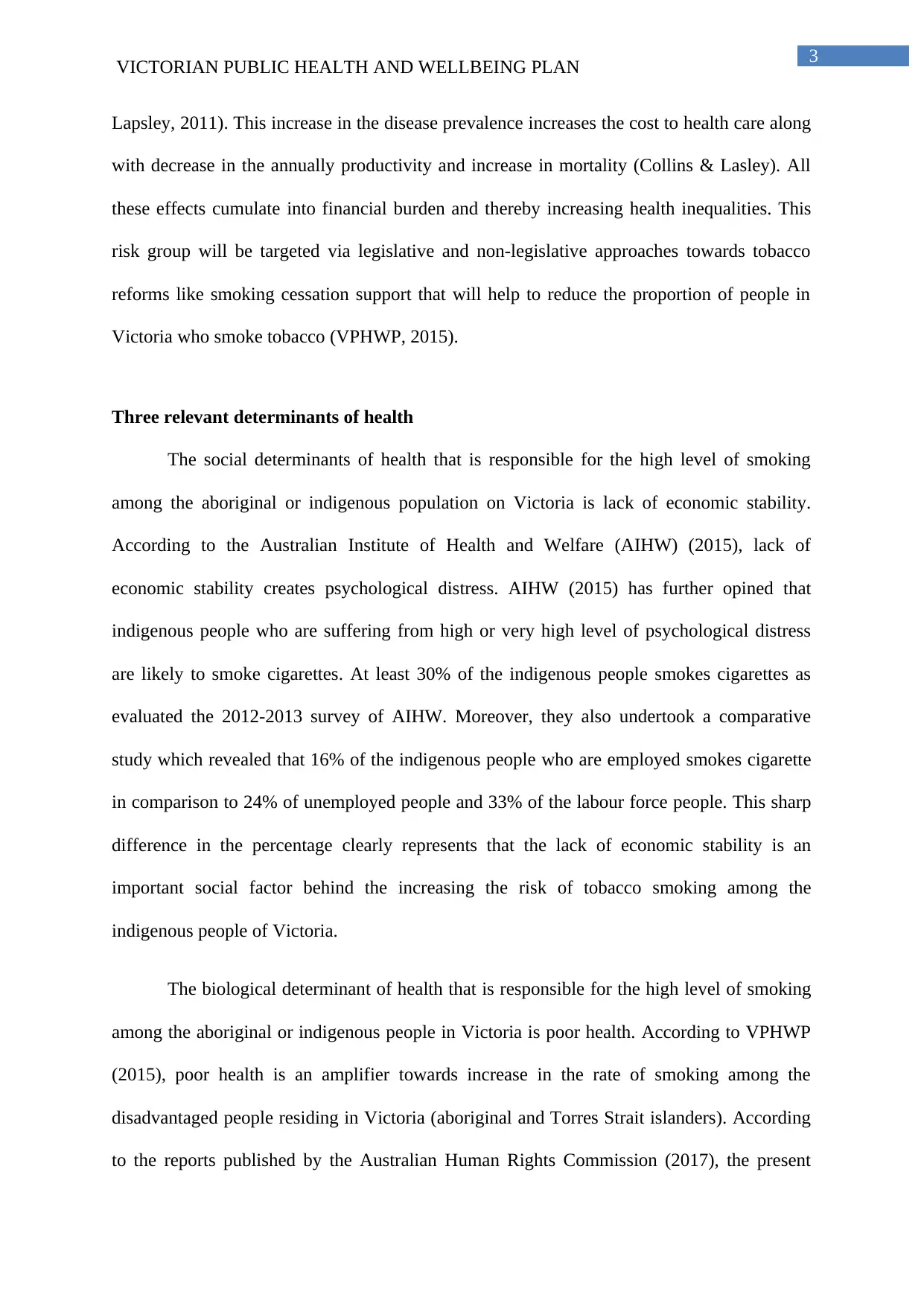
3
VICTORIAN PUBLIC HEALTH AND WELLBEING PLAN
Lapsley, 2011). This increase in the disease prevalence increases the cost to health care along
with decrease in the annually productivity and increase in mortality (Collins & Lasley). All
these effects cumulate into financial burden and thereby increasing health inequalities. This
risk group will be targeted via legislative and non-legislative approaches towards tobacco
reforms like smoking cessation support that will help to reduce the proportion of people in
Victoria who smoke tobacco (VPHWP, 2015).
Three relevant determinants of health
The social determinants of health that is responsible for the high level of smoking
among the aboriginal or indigenous population on Victoria is lack of economic stability.
According to the Australian Institute of Health and Welfare (AIHW) (2015), lack of
economic stability creates psychological distress. AIHW (2015) has further opined that
indigenous people who are suffering from high or very high level of psychological distress
are likely to smoke cigarettes. At least 30% of the indigenous people smokes cigarettes as
evaluated the 2012-2013 survey of AIHW. Moreover, they also undertook a comparative
study which revealed that 16% of the indigenous people who are employed smokes cigarette
in comparison to 24% of unemployed people and 33% of the labour force people. This sharp
difference in the percentage clearly represents that the lack of economic stability is an
important social factor behind the increasing the risk of tobacco smoking among the
indigenous people of Victoria.
The biological determinant of health that is responsible for the high level of smoking
among the aboriginal or indigenous people in Victoria is poor health. According to VPHWP
(2015), poor health is an amplifier towards increase in the rate of smoking among the
disadvantaged people residing in Victoria (aboriginal and Torres Strait islanders). According
to the reports published by the Australian Human Rights Commission (2017), the present
VICTORIAN PUBLIC HEALTH AND WELLBEING PLAN
Lapsley, 2011). This increase in the disease prevalence increases the cost to health care along
with decrease in the annually productivity and increase in mortality (Collins & Lasley). All
these effects cumulate into financial burden and thereby increasing health inequalities. This
risk group will be targeted via legislative and non-legislative approaches towards tobacco
reforms like smoking cessation support that will help to reduce the proportion of people in
Victoria who smoke tobacco (VPHWP, 2015).
Three relevant determinants of health
The social determinants of health that is responsible for the high level of smoking
among the aboriginal or indigenous population on Victoria is lack of economic stability.
According to the Australian Institute of Health and Welfare (AIHW) (2015), lack of
economic stability creates psychological distress. AIHW (2015) has further opined that
indigenous people who are suffering from high or very high level of psychological distress
are likely to smoke cigarettes. At least 30% of the indigenous people smokes cigarettes as
evaluated the 2012-2013 survey of AIHW. Moreover, they also undertook a comparative
study which revealed that 16% of the indigenous people who are employed smokes cigarette
in comparison to 24% of unemployed people and 33% of the labour force people. This sharp
difference in the percentage clearly represents that the lack of economic stability is an
important social factor behind the increasing the risk of tobacco smoking among the
indigenous people of Victoria.
The biological determinant of health that is responsible for the high level of smoking
among the aboriginal or indigenous people in Victoria is poor health. According to VPHWP
(2015), poor health is an amplifier towards increase in the rate of smoking among the
disadvantaged people residing in Victoria (aboriginal and Torres Strait islanders). According
to the reports published by the Australian Human Rights Commission (2017), the present
Paraphrase This Document
Need a fresh take? Get an instant paraphrase of this document with our AI Paraphraser
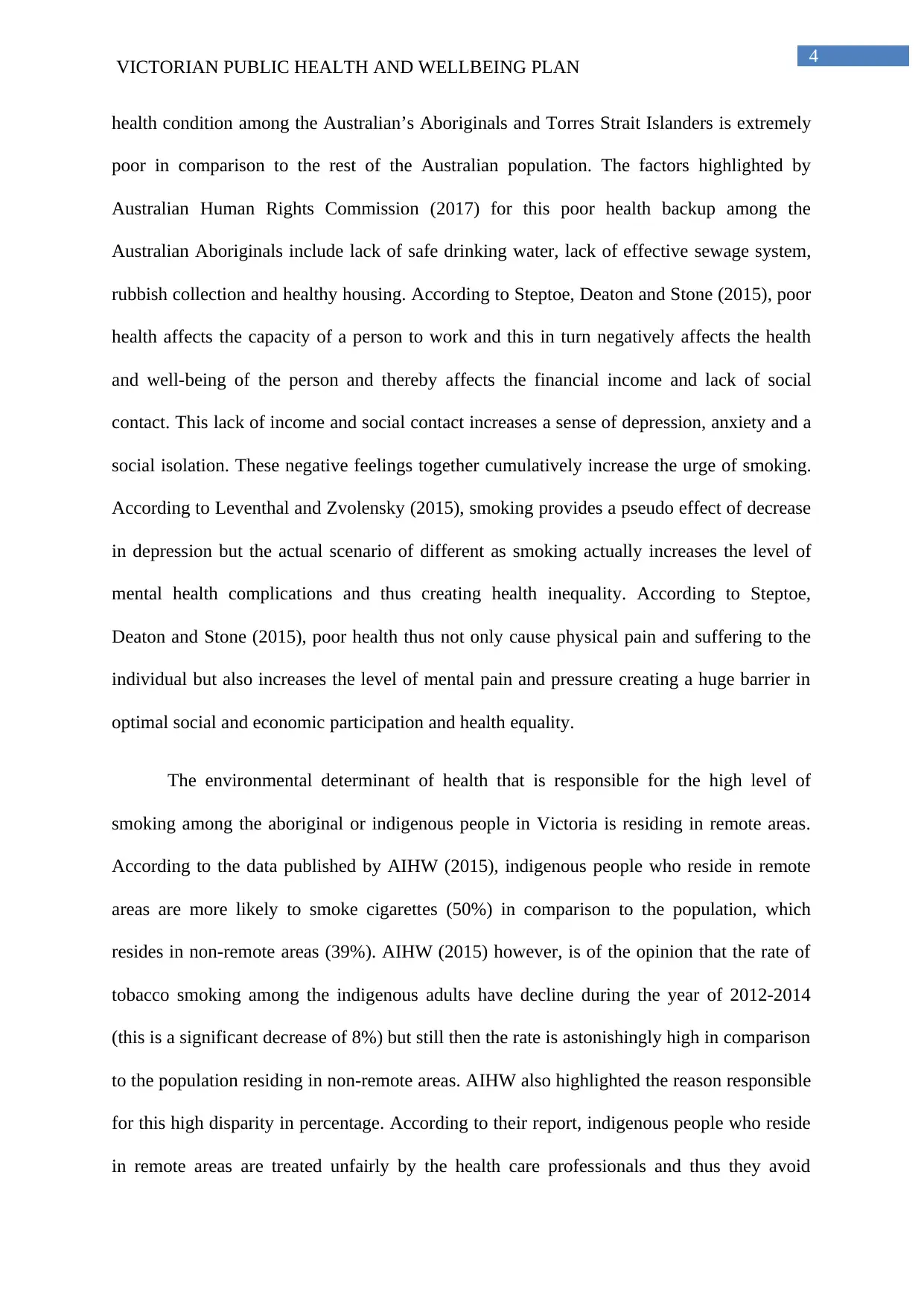
4
VICTORIAN PUBLIC HEALTH AND WELLBEING PLAN
health condition among the Australian’s Aboriginals and Torres Strait Islanders is extremely
poor in comparison to the rest of the Australian population. The factors highlighted by
Australian Human Rights Commission (2017) for this poor health backup among the
Australian Aboriginals include lack of safe drinking water, lack of effective sewage system,
rubbish collection and healthy housing. According to Steptoe, Deaton and Stone (2015), poor
health affects the capacity of a person to work and this in turn negatively affects the health
and well-being of the person and thereby affects the financial income and lack of social
contact. This lack of income and social contact increases a sense of depression, anxiety and a
social isolation. These negative feelings together cumulatively increase the urge of smoking.
According to Leventhal and Zvolensky (2015), smoking provides a pseudo effect of decrease
in depression but the actual scenario of different as smoking actually increases the level of
mental health complications and thus creating health inequality. According to Steptoe,
Deaton and Stone (2015), poor health thus not only cause physical pain and suffering to the
individual but also increases the level of mental pain and pressure creating a huge barrier in
optimal social and economic participation and health equality.
The environmental determinant of health that is responsible for the high level of
smoking among the aboriginal or indigenous people in Victoria is residing in remote areas.
According to the data published by AIHW (2015), indigenous people who reside in remote
areas are more likely to smoke cigarettes (50%) in comparison to the population, which
resides in non-remote areas (39%). AIHW (2015) however, is of the opinion that the rate of
tobacco smoking among the indigenous adults have decline during the year of 2012-2014
(this is a significant decrease of 8%) but still then the rate is astonishingly high in comparison
to the population residing in non-remote areas. AIHW also highlighted the reason responsible
for this high disparity in percentage. According to their report, indigenous people who reside
in remote areas are treated unfairly by the health care professionals and thus they avoid
VICTORIAN PUBLIC HEALTH AND WELLBEING PLAN
health condition among the Australian’s Aboriginals and Torres Strait Islanders is extremely
poor in comparison to the rest of the Australian population. The factors highlighted by
Australian Human Rights Commission (2017) for this poor health backup among the
Australian Aboriginals include lack of safe drinking water, lack of effective sewage system,
rubbish collection and healthy housing. According to Steptoe, Deaton and Stone (2015), poor
health affects the capacity of a person to work and this in turn negatively affects the health
and well-being of the person and thereby affects the financial income and lack of social
contact. This lack of income and social contact increases a sense of depression, anxiety and a
social isolation. These negative feelings together cumulatively increase the urge of smoking.
According to Leventhal and Zvolensky (2015), smoking provides a pseudo effect of decrease
in depression but the actual scenario of different as smoking actually increases the level of
mental health complications and thus creating health inequality. According to Steptoe,
Deaton and Stone (2015), poor health thus not only cause physical pain and suffering to the
individual but also increases the level of mental pain and pressure creating a huge barrier in
optimal social and economic participation and health equality.
The environmental determinant of health that is responsible for the high level of
smoking among the aboriginal or indigenous people in Victoria is residing in remote areas.
According to the data published by AIHW (2015), indigenous people who reside in remote
areas are more likely to smoke cigarettes (50%) in comparison to the population, which
resides in non-remote areas (39%). AIHW (2015) however, is of the opinion that the rate of
tobacco smoking among the indigenous adults have decline during the year of 2012-2014
(this is a significant decrease of 8%) but still then the rate is astonishingly high in comparison
to the population residing in non-remote areas. AIHW also highlighted the reason responsible
for this high disparity in percentage. According to their report, indigenous people who reside
in remote areas are treated unfairly by the health care professionals and thus they avoid
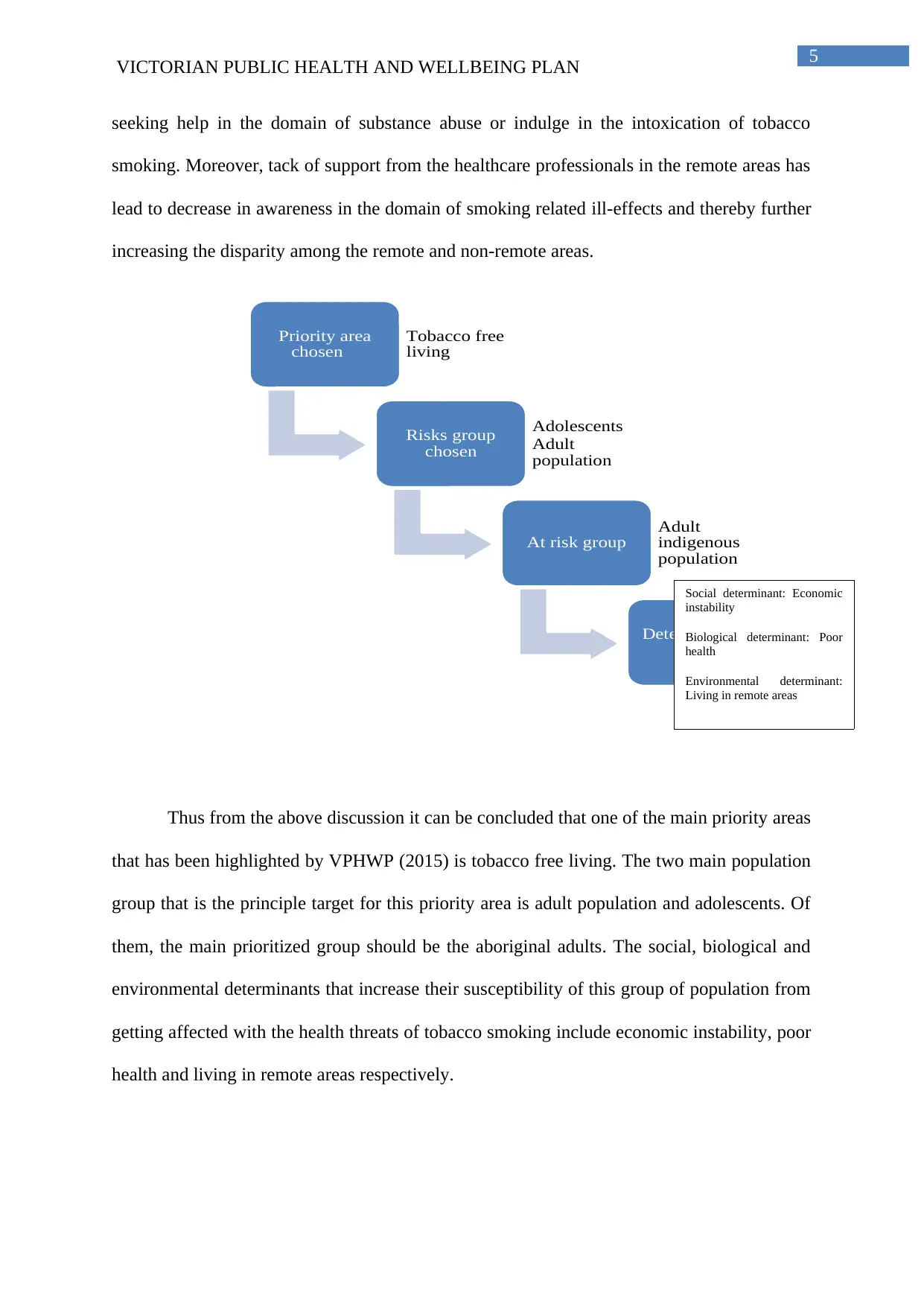
5
VICTORIAN PUBLIC HEALTH AND WELLBEING PLAN
seeking help in the domain of substance abuse or indulge in the intoxication of tobacco
smoking. Moreover, tack of support from the healthcare professionals in the remote areas has
lead to decrease in awareness in the domain of smoking related ill-effects and thereby further
increasing the disparity among the remote and non-remote areas.
Thus from the above discussion it can be concluded that one of the main priority areas
that has been highlighted by VPHWP (2015) is tobacco free living. The two main population
group that is the principle target for this priority area is adult population and adolescents. Of
them, the main prioritized group should be the aboriginal adults. The social, biological and
environmental determinants that increase their susceptibility of this group of population from
getting affected with the health threats of tobacco smoking include economic instability, poor
health and living in remote areas respectively.
Priority area
chosen
Tobacco free
living
Risks group
chosen
Adolescents
Adult
population
At risk group
Adult
indigenous
population
Determinants of
health
Social determinant: Economic
instability
Biological determinant: Poor
health
Environmental determinant:
Living in remote areas
VICTORIAN PUBLIC HEALTH AND WELLBEING PLAN
seeking help in the domain of substance abuse or indulge in the intoxication of tobacco
smoking. Moreover, tack of support from the healthcare professionals in the remote areas has
lead to decrease in awareness in the domain of smoking related ill-effects and thereby further
increasing the disparity among the remote and non-remote areas.
Thus from the above discussion it can be concluded that one of the main priority areas
that has been highlighted by VPHWP (2015) is tobacco free living. The two main population
group that is the principle target for this priority area is adult population and adolescents. Of
them, the main prioritized group should be the aboriginal adults. The social, biological and
environmental determinants that increase their susceptibility of this group of population from
getting affected with the health threats of tobacco smoking include economic instability, poor
health and living in remote areas respectively.
Priority area
chosen
Tobacco free
living
Risks group
chosen
Adolescents
Adult
population
At risk group
Adult
indigenous
population
Determinants of
health
Social determinant: Economic
instability
Biological determinant: Poor
health
Environmental determinant:
Living in remote areas
⊘ This is a preview!⊘
Do you want full access?
Subscribe today to unlock all pages.

Trusted by 1+ million students worldwide
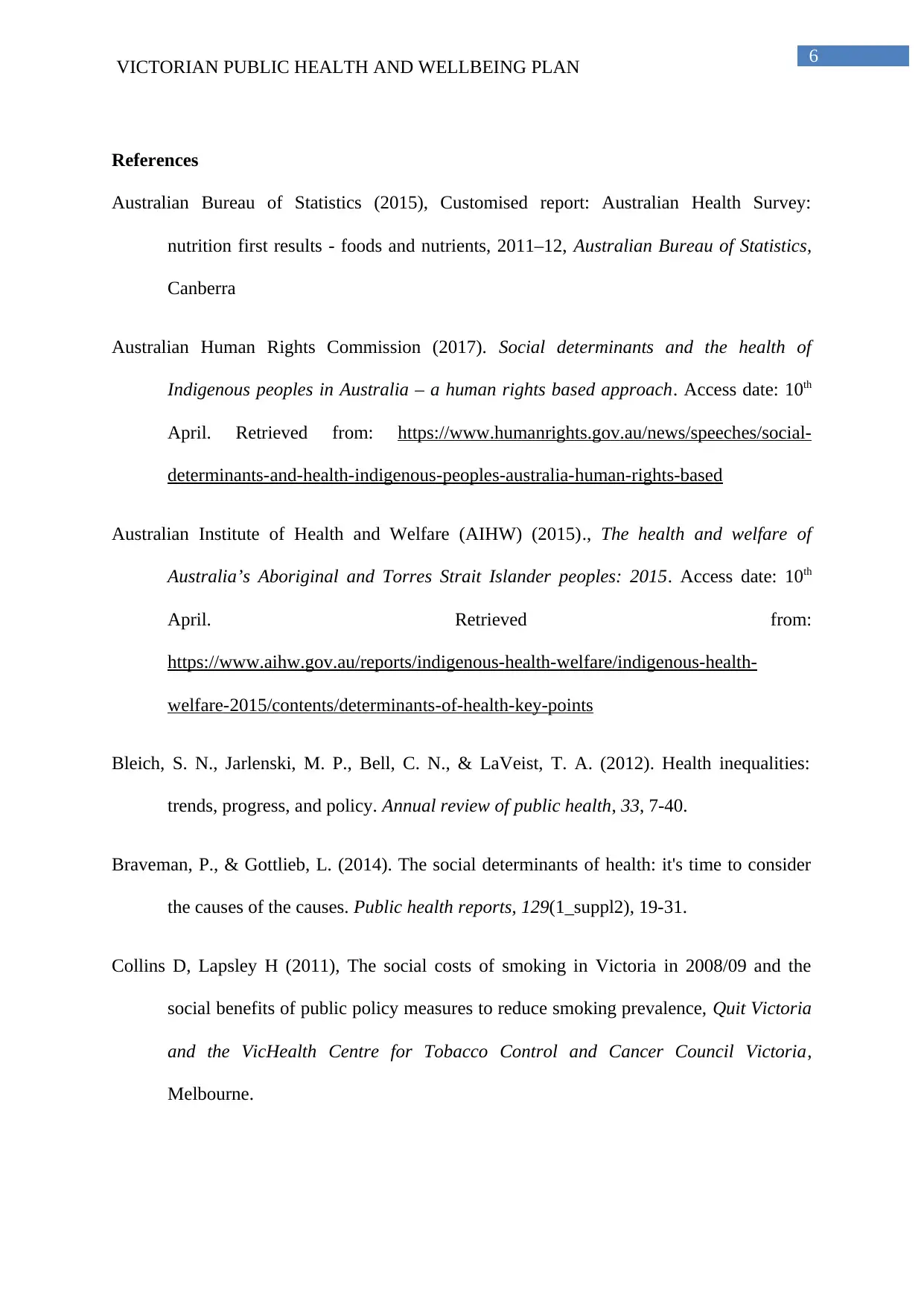
6
VICTORIAN PUBLIC HEALTH AND WELLBEING PLAN
References
Australian Bureau of Statistics (2015), Customised report: Australian Health Survey:
nutrition first results - foods and nutrients, 2011–12, Australian Bureau of Statistics,
Canberra
Australian Human Rights Commission (2017). Social determinants and the health of
Indigenous peoples in Australia – a human rights based approach. Access date: 10th
April. Retrieved from: https://www.humanrights.gov.au/news/speeches/social-
determinants-and-health-indigenous-peoples-australia-human-rights-based
Australian Institute of Health and Welfare (AIHW) (2015)., The health and welfare of
Australia’s Aboriginal and Torres Strait Islander peoples: 2015. Access date: 10th
April. Retrieved from:
https://www.aihw.gov.au/reports/indigenous-health-welfare/indigenous-health-
welfare-2015/contents/determinants-of-health-key-points
Bleich, S. N., Jarlenski, M. P., Bell, C. N., & LaVeist, T. A. (2012). Health inequalities:
trends, progress, and policy. Annual review of public health, 33, 7-40.
Braveman, P., & Gottlieb, L. (2014). The social determinants of health: it's time to consider
the causes of the causes. Public health reports, 129(1_suppl2), 19-31.
Collins D, Lapsley H (2011), The social costs of smoking in Victoria in 2008/09 and the
social benefits of public policy measures to reduce smoking prevalence, Quit Victoria
and the VicHealth Centre for Tobacco Control and Cancer Council Victoria,
Melbourne.
VICTORIAN PUBLIC HEALTH AND WELLBEING PLAN
References
Australian Bureau of Statistics (2015), Customised report: Australian Health Survey:
nutrition first results - foods and nutrients, 2011–12, Australian Bureau of Statistics,
Canberra
Australian Human Rights Commission (2017). Social determinants and the health of
Indigenous peoples in Australia – a human rights based approach. Access date: 10th
April. Retrieved from: https://www.humanrights.gov.au/news/speeches/social-
determinants-and-health-indigenous-peoples-australia-human-rights-based
Australian Institute of Health and Welfare (AIHW) (2015)., The health and welfare of
Australia’s Aboriginal and Torres Strait Islander peoples: 2015. Access date: 10th
April. Retrieved from:
https://www.aihw.gov.au/reports/indigenous-health-welfare/indigenous-health-
welfare-2015/contents/determinants-of-health-key-points
Bleich, S. N., Jarlenski, M. P., Bell, C. N., & LaVeist, T. A. (2012). Health inequalities:
trends, progress, and policy. Annual review of public health, 33, 7-40.
Braveman, P., & Gottlieb, L. (2014). The social determinants of health: it's time to consider
the causes of the causes. Public health reports, 129(1_suppl2), 19-31.
Collins D, Lapsley H (2011), The social costs of smoking in Victoria in 2008/09 and the
social benefits of public policy measures to reduce smoking prevalence, Quit Victoria
and the VicHealth Centre for Tobacco Control and Cancer Council Victoria,
Melbourne.
Paraphrase This Document
Need a fresh take? Get an instant paraphrase of this document with our AI Paraphraser
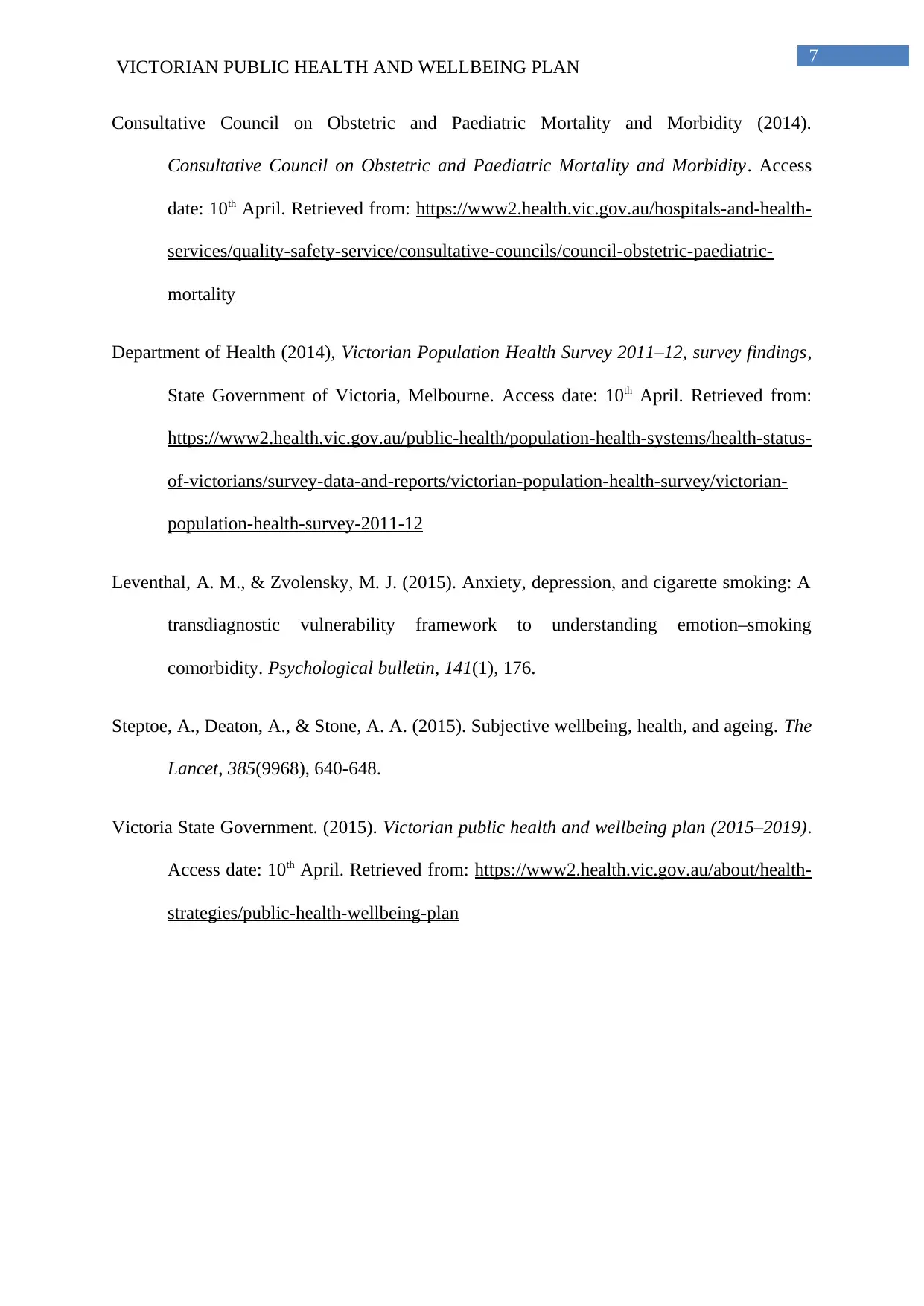
7
VICTORIAN PUBLIC HEALTH AND WELLBEING PLAN
Consultative Council on Obstetric and Paediatric Mortality and Morbidity (2014).
Consultative Council on Obstetric and Paediatric Mortality and Morbidity. Access
date: 10th April. Retrieved from: https://www2.health.vic.gov.au/hospitals-and-health-
services/quality-safety-service/consultative-councils/council-obstetric-paediatric-
mortality
Department of Health (2014), Victorian Population Health Survey 2011–12, survey findings,
State Government of Victoria, Melbourne. Access date: 10th April. Retrieved from:
https://www2.health.vic.gov.au/public-health/population-health-systems/health-status-
of-victorians/survey-data-and-reports/victorian-population-health-survey/victorian-
population-health-survey-2011-12
Leventhal, A. M., & Zvolensky, M. J. (2015). Anxiety, depression, and cigarette smoking: A
transdiagnostic vulnerability framework to understanding emotion–smoking
comorbidity. Psychological bulletin, 141(1), 176.
Steptoe, A., Deaton, A., & Stone, A. A. (2015). Subjective wellbeing, health, and ageing. The
Lancet, 385(9968), 640-648.
Victoria State Government. (2015). Victorian public health and wellbeing plan (2015–2019).
Access date: 10th April. Retrieved from: https://www2.health.vic.gov.au/about/health-
strategies/public-health-wellbeing-plan
VICTORIAN PUBLIC HEALTH AND WELLBEING PLAN
Consultative Council on Obstetric and Paediatric Mortality and Morbidity (2014).
Consultative Council on Obstetric and Paediatric Mortality and Morbidity. Access
date: 10th April. Retrieved from: https://www2.health.vic.gov.au/hospitals-and-health-
services/quality-safety-service/consultative-councils/council-obstetric-paediatric-
mortality
Department of Health (2014), Victorian Population Health Survey 2011–12, survey findings,
State Government of Victoria, Melbourne. Access date: 10th April. Retrieved from:
https://www2.health.vic.gov.au/public-health/population-health-systems/health-status-
of-victorians/survey-data-and-reports/victorian-population-health-survey/victorian-
population-health-survey-2011-12
Leventhal, A. M., & Zvolensky, M. J. (2015). Anxiety, depression, and cigarette smoking: A
transdiagnostic vulnerability framework to understanding emotion–smoking
comorbidity. Psychological bulletin, 141(1), 176.
Steptoe, A., Deaton, A., & Stone, A. A. (2015). Subjective wellbeing, health, and ageing. The
Lancet, 385(9968), 640-648.
Victoria State Government. (2015). Victorian public health and wellbeing plan (2015–2019).
Access date: 10th April. Retrieved from: https://www2.health.vic.gov.au/about/health-
strategies/public-health-wellbeing-plan
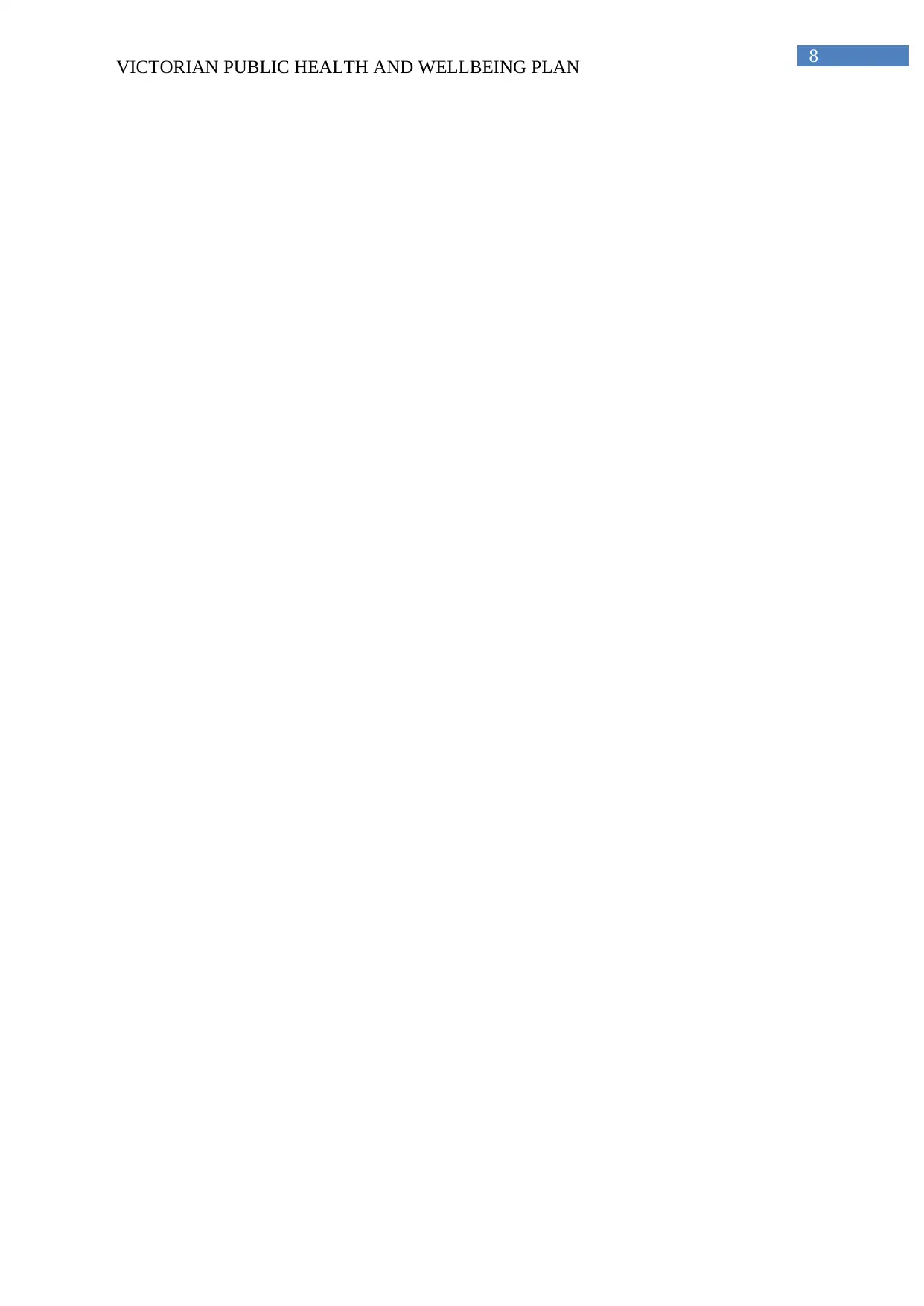
8
VICTORIAN PUBLIC HEALTH AND WELLBEING PLAN
VICTORIAN PUBLIC HEALTH AND WELLBEING PLAN
⊘ This is a preview!⊘
Do you want full access?
Subscribe today to unlock all pages.

Trusted by 1+ million students worldwide
1 out of 9
Related Documents
Your All-in-One AI-Powered Toolkit for Academic Success.
+13062052269
info@desklib.com
Available 24*7 on WhatsApp / Email
![[object Object]](/_next/static/media/star-bottom.7253800d.svg)
Unlock your academic potential
Copyright © 2020–2025 A2Z Services. All Rights Reserved. Developed and managed by ZUCOL.





